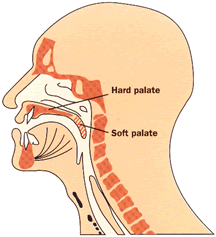| enginuity |
|
Silent night
It was Prof Shon Ffowcs Williams' reputation in the field of anti-sound that first brought consultant surgeon Peter Ellis from Addenbrookes to enquire whether he could produce an anti-snoring device. Although snorers tend to be the butt of many jokes, sleep disturbance caused by severe snoring has been shown to produce a higher than normal risk of death both from accidental and natural causes and is often the cause of marital disharmony.
Although anti-sound was unlikely to prove useful in this application, Ffowcs Williams was interested in helping to find a cure and he collaborated with doctors to interpret clinical observations. It was not long before he devised a mechanical model simulating the palate and upper airway. It comprised a round tube divided into two channels by a rigid partition equivalent to the hard palate and a short length of flexible material, analogous to the soft palate. When air is sucked through the tube above a critical speed, the flexible membrane vibrates and a sound similar to snoring is produced. Mathematical and mechanical modelling of the movements of the soft palate indicated that the flutter could be reduced by stiffening. This can be effectively demonstrated using the mechanical model, by sandwiching the soft material with Sellotape. On a patient, the same effect can be produced by causing scar tissue to form on the palate following removal of a strip of mucosa from the soft palate using a Nd-YAG laser and allowing the wound to heal naturally.

Clinical trials have shown the operation to be successful, with most patients reporting substantial reduction or total abolition of snoring. Where the result of the operation was not successful, it was discovered that snoring had been caused by mechanisms other than palatal flutter. One of Ffowcs Williams' students Lixi Huang, proceeded to develop diagnostic tools using dual measurements from small microphones in the upper and lower airways to assess whether palatal flutter was the cause of patients' snoring. Where palatal flutter was diagnosed, then a cure could be effected surgically as described.
'These developments do not represent great advances in the field of acoustic engineering or in the medical world, but they do show that advances can be made through interdisciplinary interaction,' says Prof Ffowcs Williams, and it is this that he finds so stimulating. Interest in the work has now been expressed by a member of the Vet School where dogs of the short nose variety cause themselves and their owners anguish because of their snoring... and so the work goes on.
Further information from Prof Shon Ffowcs Williams on: (01223) 332629.
| number 3, summer '94 |